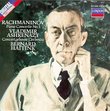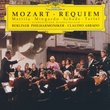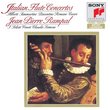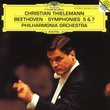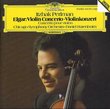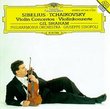| All Artists: Leonardo Balada, Jorge Mester, Juan Pablo Izquierdo, Carnegie Mellon Philharmonic, Louisville Orchestra, Guillermo Helguera, Nancy Maria Balach Title: Balada: Maria Sabina Members Wishing: 0 Total Copies: 0 Label: New World Records Release Date: 12/5/1995 Genre: Classical Styles: Opera & Classical Vocal, Chamber Music, Symphonies Number of Discs: 1 SwapaCD Credits: 1 UPC: 093228049821 |
Search - Leonardo Balada, Jorge Mester, Juan Pablo Izquierdo :: Balada: Maria Sabina
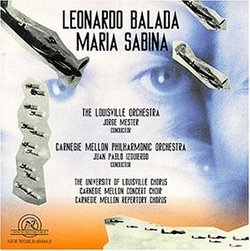 | Leonardo Balada, Jorge Mester, Juan Pablo Izquierdo Balada: Maria Sabina Genre: Classical
|
Larger Image |
CD DetailsSimilarly Requested CDs |
CD ReviewsCompositions of great originality and tremendous dramatic im Discophage | France | 11/21/2007 (5 out of 5 stars) "I wasn't prepared for this.
I had encountered the music of Spanish-born Leonardo Balada before - he studied at Juilliard and was active in the US, and became a naturalized American citizen in 1981, so it is difficult to decide whether he should be considered as a Spanish or an American composer (not that it matters much). I purchased a few years ago the New World disc with his cantata Torquemada and other works and had rather enjoyed it, but it didn't really leave a mark in memory (Balada: Torquemada and Other Works); I gave a good review to his Steel Symphony performed by the Pittsburgh Symphony under Maazel (paired with Schuman's 7th), but as enjoyable as it is, I certainly wouldn't consider it to belong to the most essential masterpiece of late 20th music (William Schuman: Symphony No. 7; Leonardo Balada: Steel Symphony). Then, as far as I am aware, Balada doesn't have the reputation of one of the essential masters of contemporary music from the 1960s on, either Spanish (that award would go to Cristobal Halffter I'd say) or American (many contenders - Crumb is one of my favorites). Yet "Maria Sabina" is a magnificent work, equal to anything written in those days, with many similitudes I find with Penderecki's St-Luke's Passion and Utrenja, as advanced in its language and as powerful and dramatic as these two epoch-making compositions. The orchestra is not used for melody but displays an array of strange and eerie sounds effects, all of great coloristic and dramatic impact. "Maria Sabina", composed in 1969, is described as "A Symphonic Tragedy in Three Parts", for narrators, chorus and orchestra. It is a kind of cantata, or maybe an opera after a real character, a more or less clandestine Mexican mushroom-cult priestess who was still alive when the work was premiered (notwithstanding the libretto depicts her death), but Balada's approach to text is of great originality. While the chorus does sing (as well as shouts), the narrators, and especially Maria Sabina, speak in an hallucinatory manner the hallucinatory text by the great Spanish author Camilo José Cela (who was afforded the Nobel Prize for Literature in 1989). The libretto in itself also has great dramatic and poetic impact, bearing heavily on the stylistic procedure called "anaphora", or the repetition of a word or expression at the beginning of successive phrases (there are for instance 73 phrases starting with "Soy una mujer.." - I am a woman - that are machine-gunned in four minutes, starting at 3:15), and with a no-holds-barred, graphic crudeness. This recording is a reissue of a Louisville recording first published on LP on the orchestra's First Edition Recordings LS 726. Apparently the original version was 90 minutes-long and this is a reduced version of 35 minutes. I'd love to hear the long one. The cast and orchestra's achievement under Jorge Mester sounds impressive, and the Louisville recording from 1973 is outstanding. My only quibble is that there is only one access point: the different sections could and should have been cued. The scenes which Balada excerpted in 1992 under the title "Escenas Borrascosas" (Thunderous Scenes) from the opera he was then in the process of writing, "Death of Columbus" (premiered two years later), though still quite effective, are not as original. By then, Balada had moved to what he himself describes as his third compositional period, and reintroduced melody in his compositional processes. The orchestra remains quite dramatically colorful and advanced in its language, but the vocal writing is much more traditional-sounding and doesn't have the same kind of impact as the vociferations of Maria Sabina The recording by the Carnegie-Mellon forces (where Balada was composition professor) under Juan Pablo Izquierdo was made for this CD release and each scene is cued. Guernica (1966) is an orchestral piece evoking Picasso's painting of the Nazi-bombed Basque village, and another reissue from a Louisville recording from circa 1969 (exact date not provided by New World), Lou 686, which came back then with Gunther Schuller's Five Bagatelles for Orchestra and Dallapiccola's Piccola Musica Notturna (both as yet unreissued on CD). We are back in Balada's second period, the music uses controlled aleatoric devices, clusters, antiphonal effects, quarter-tone glissandos, and again it has great dramatic impact. The music of Karel Husa comes to mind, with whom Balada shares a willingness to use the full array of devices and techniques offered by the most advanced contemporary music, but always at the service of great dramatic and theatrical impact. So now I am wondering why Balada doesn't enjoy a greater stature and recognition. " |

 Track Listings (6) - Disc #1
Track Listings (6) - Disc #1